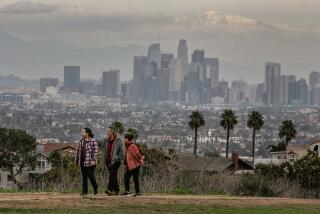A dry but cold New Year’s forecast
- Share via
University of Wisconsin fans in Pasadena to watch their Badgers play in the Rose Bowl on New Year’s Day may find the coming weather balmy, but Southern Californians are about to experience a biting cold snap.
The region is expected to get a brief break from the rain that has drenched it for the better part of two weeks. Now, however, it’s going to get chilly, said Stuart Seto, a weather specialist for the National Weather Service in Oxnard.
The temperature in Pasadena should dip into the low 40s about sunrise Saturday, forcing many spectators awaiting the Rose Parade to bundle up. But that’s nothing compared to the expected temperature in Woodland Hills on Friday morning, when the mercury should drop to 31 degrees, Seto said.
Even downtown L.A. could experience temperatures below 40 degrees Friday morning, he said.
“We’re going to see some really chilly temperatures,” Seto said. “Below freezing in some places, right around sunrise.”
The snow levels on north-facing mountain slopes, including along parts of the Grapevine, should creep down to about 2,500 feet, he said, adding that white-out conditions because of snow are likely from Bishop north to Mammoth Lakes.
Daytime highs in the Southland, at least through the weekend, should be in the high 50s to low 60s, including in downtown L.A. But a warm-up could be on the way by Wednesday, Seto said.
The good news, he said, is that it’s not expected to rain on the Rose Parade or Rose Bowl game, during which Wisconsin will face off with Texas Christian University. But there’s a chance of rain Saturday evening, Seto said.
Meanwhile, gusty winds — as strong as 80 mph in the mountain passes — could prevail in much of Southern California into Thursday, prompting gale warnings along the coast.
“If you have a boat trip to Catalina planned, you won’t be going,” Seto said.
L.A. has received more than 10 inches of rain in December, only the second time that’s happened since 1878. The wettest December, with 15.8 inches, was in 1889. The winter storms have raised concerns about possible landslides, debris flows and flooding, particularly if strong rains continue.
January, February and March are historically Southern California’s wettest months, and weather experts say that in a normal year, such a wet December could presage a generally sopping few months. But a strong La Niña in the central Pacific could eventually turn the spigot off for the rest of the winter.
December’s persistent rains have caused substantial damage. Several sections of California Highway 330, a key route to Big Bear in the San Bernardino National Forest, were washed away by the storms. According to San Bernardino County officials, that county has suffered $59 million in storm damage.
The rainstorms underscored the danger posed by blue gum eucalyptus trees along the northern boundary of Yvonne B. Burke Park in Marina del Rey. Arborists working for L.A. County determined that because of a fungal infection, more than 60 trees in the park could suddenly collapse.
In the last week, two of the trees came crashing down after being buffeted by the storms. County officials said 17 of the trees will be immediately removed because they pose a danger to residents, cyclists and pedestrians.
On Wednesday, acting Gov. Abel Maldonado sent a letter to President Obama urging him to declare a disaster in California because of the storm damage. Such a declaration would help speed up federal money and aid to the affected communities.
More to Read
Sign up for Essential California
The most important California stories and recommendations in your inbox every morning.
You may occasionally receive promotional content from the Los Angeles Times.














